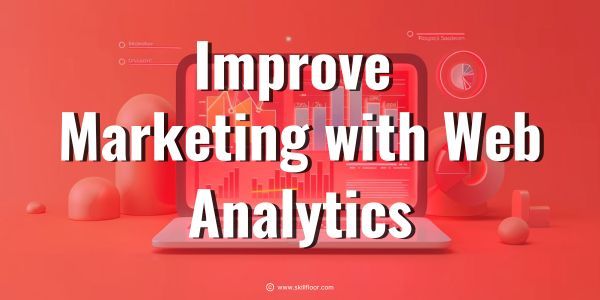The Role of Web Analytics in Digital Marketing
How web analytics enhances digital marketing success by tracking user behavior, optimizing campaigns, and driving data-driven decisions.

Through my experience working with a variety of companies over the years, I've discovered that web analytics is a revolutionary tool for comprehending online performance. It gives you a comprehensive picture of how your visitors behave, highlighting what is and is not effective. Businesses may use this information to enhance their approach and increase outcomes.
Digital marketing specialists agree that web analytics are critical to success. Without it, you have to assume what's effective. Google Analytics and other similar tools provide you with useful information to help you refine your tactics. Using this data, I have witnessed businesses flourish; one customer had a 25% increase in interaction after making changes to their sites based on analytics input.
What is Web Analytics?
Web analytics is a tool that helps businesses track and analyze what’s happening on their website. It gathers information on user interaction with your content, traffic sources, and visitor behavior. You may use this information to make well-informed decisions that will enhance your website and your entire efforts at digital marketing.
Web analytics in digital marketing assists companies in making well-informed choices. Businesses may increase client interaction, refine their tactics, and ultimately get better outcomes by monitoring important indicators like user behavior and conversions.
Key Components of Web Analytics
-
Traffic Sources: This displays the sources of traffic to your website, including search engines, social media, direct visits, and website referrals.
-
Page Views: Keeps track of how many times each page on your website is seen, which can help you determine which content appeals to your audience the most.
-
Bounce Rate: Determines the proportion of users that depart your website after only one page is seen, suggesting possible problems with user experience or connection.
-
Conversion Rate: Monitors the proportion of site visitors that finish a desired activity, such buying something or subscribing to a newsletter.
-
User Behavior: Determines which pages users view, how long they remain on your site, and where they leave off after navigating through it.
-
Exit Pages: Determines which pages users were on when they left your website, providing information about potential problems with the design or content that may need to be fixed.
-
Goal Tracking: This enables you to monitor how well your website is performing about specified goals, such as form submissions or downloads.
Two Main Types of Web Analytics
1. On-Site Web Analytics: This method focuses on examining how users interact with your website. Monitoring information like page views, bounce rates, and conversion rates, assists companies in better understanding how users engage with their websites and improving user experience.
2. Off-Site Web Analytics: Off-site analytics evaluates a company's whole online presence, including how well your website is doing to others. It monitors data like search engine rankings, social media mentions, and general exposure to determine how well your internet marketing campaigns are working.
Types of Web Analytics in Digital Marketing
-
Descriptive Analytics: Past events are the main focus of this type. To offer insights into previous performance, it gathers historical data such as website traffic, page views, and bounce rates.
-
Diagnostic Analytics: Diagnostic analytics examines the data in further detail to determine the cause of an event. It assists in determining the causes of high bounce rates or a drop in traffic.
-
Predictive Analytics: Predictive analytics makes future trends and behaviors predictions based on past data. It assists companies in anticipating consumer behavior and adjusting their marketing strategies accordingly.
-
Prescriptive Analytics: This advanced form of analytics makes recommendations for particular steps to follow to achieve future results. It recommends the optimal course of action by combining machine learning and data analysis.
-
Real-Time Analytics: Real-time analytics track the activities of a website in real-time. It helps monitor ongoing campaigns, quickly analyzing user behavior, and making quick corrections.
-
Behavioral Analytics: This type of analytics, which focuses on user behavior, monitors how users interact with your website, including page clicks and time spent, and helps you improve user engagement by optimizing the user experience.
Benefits of Web Analytics in Digital Marketing
-
Improves Decision-Making: Web analytics ensures that your marketing efforts are more successful by letting you know what is and is not working, allowing you to make more informed decisions.
-
Tracks Campaign Performance: You can quickly track the effectiveness of marketing campaigns and see which tactics are generating leads, sales, and traffic, which will help you focus your future efforts.
-
Enhances User Experience: By examining user behavior, you may pinpoint areas where your website is lacking and implement fixes to provide users a more seamless and pleasurable experience.
-
Boosts Conversion Rates: Businesses may use web analytics in digital marketing to pinpoint visitor drop-off points and make adjustments that improve customer engagement and conversion rates.
-
Optimizes Marketing Budget: By optimizing your return on investment, cutting down on waste, and concentrating resources on the most productive channels, web analytics helps you spend your marketing budget properly.
-
Provides Competitive Edge: Continuous performance monitoring helps you remain ahead of the competition by seeing emerging trends and opportunities, which enables your company to react swiftly to shifts in the market.

Importance of Web Analytics in Digital Marketing
Working with companies of various sizes has shown me how important audience comprehension is to the success of digital marketing. Businesses may monitor important data like traffic and conversions with web analytics, which enables them to modify tactics like enhancing Search Engine Optimization or fine-tuning ad targeting for increased effectiveness and expansion.
Web analytics is essential for success, according to specialists in digital marketing. Research indicates that businesses that employ data-driven tactics outperform their rivals and obtain a higher return on investment. Top websites employ tools like Google Analytics to better study consumer behavior, improve tactics, and maintain competitiveness in the always-changing online market.
The advantages of web analytics are indisputable, but they may first appear overwhelming, particularly to those who are unfamiliar with digital marketing. By concentrating on the most efficient channels, I have witnessed customers achieve fantastic outcomes, such as a 25% reduction in marketing expenses. Smarter, more certain marketing decisions are the result of data-driven insights.
Best Practices for Implementing Web Analytics in Digital Marketing
1. Define Clear Goals
Establish clear goals first, such as raising conversions or enhancing engagement. Setting clear objectives enables you to concentrate your digital marketing efforts and use web analytics data to track your success.
2. Choose the Right Tools
Google Analytics is a well-liked web analytics tool; choose one that works for your online marketing initiatives. To track the most accurate data possible, make sure it is installed correctly on your website.
3. Set Up Tracking for Key Metrics
Decide which key performance indicators to track regularly, such as traffic, bounce rates, and conversions. By using this information, you may improve the efficacy of your online marketing and provide better outcomes for your company.

4. Segment Your Audience
Divide the people who visit your website into groups according to their demographics or behavior. By tailoring material to the particular requirements of various client categories, you may improve your marketing initiatives.
5. Monitor Data Regularly
Analyze your web analytics data regularly to spot patterns and possible areas for development. Regular monitoring enables you to make appropriate modifications for the success of your digital marketing campaigns and maintains them on course.
6. Test and Optimize
A/B testing may be used to compare several versions of your website or campaigns. Applying the findings can help you improve your marketing tactics over time for more engagement and conversions.
How to Use Web Analytics for Digital Marketing Success
1. Track Your Campaign Performance
For each campaign, monitor traffic, engagement, and conversions using web analytics in digital marketing. With the use of this data, you can improve your strategy and determine what is effective.
2. Understand Your Audience
Important information regarding visitor behavior, demographics, and preferences may be found through web analytics. Utilize this data to better target your digital marketing campaigns and establish a connection with the appropriate audience.
3. Optimize Website Content
You may find out the content resonates best by looking at visitor behavior. This enables you to provide interesting content that complements your digital marketing initiatives and improves underperforming pages.
4. Improve Conversion Rates
Analyzing the conversion funnel with web analytics in digital marketing aids in identifying the points at which visitors lose interest. Conversions may be greatly increased by enhancing calls-to-action or making the required design adjustments.
5. Allocate Resources Efficiently
Finding the most effective marketing channels, such as social media, SEO, or paid advertisements, is made easier with the use of web analytics. Spend money and resources on the channels that will yield the highest return on investment.
6. Measure ROI
The ROI of your digital marketing efforts is tracked by web analytics, which enables you to evaluate each strategy's efficacy and modify your expenditures to concentrate on the most productive ones.
Essential Website Analytics Tools for Digital Marketing
Google Analytics, one of the most popular tools, provides detailed information on user activity, website traffic, and conversion rates. It's essential for monitoring how well your digital marketing campaigns are working.
2. Matomo
With Matomo, you can manage all of your data without depending on outside parties thanks to its robust, open-source web analytics platform. It's a fantastic substitute for marketers who value openness and privacy in digital marketing.
3. SEMrush
SEMrush is a well-liked tool for competition and website analysis. It is a great tool for enhancing SEO in digital marketing initiatives as it tracks keywords, backlinks, and organic traffic.
4. Hotjar
Hotjar offers session records and heatmaps to demonstrate how users navigate your website. This tool is crucial to web analytics in digital marketing since it identifies areas that require improved functionality or design to improve user experience.

5. Crazy Egg
Crazy Egg provides visual tools like A/B testing, scroll maps, and heatmaps. Marketers who wish to make data-driven changes and gain a visual understanding of how consumers interact with their website will find it ideal.
6. Moz Pro
Moz Pro is an SEO-focused tool that supports link-building, site audits, and keyword rankings. For companies trying to increase their search engine exposure as part of their digital marketing strategy, it is crucial.
7. Ahrefs
Ahrefs is frequently used for keyword research, backlink monitoring, and competitive analysis. It is a complete instrument for increasing the authority of websites and getting a competitive advantage in digital marketing.
Future Trends in Web Analytics for Digital Marketing
1. Artificial Intelligence and Machine Learning
AI and machine learning are revolutionizing web analytics. These technologies provide predictive insights and automate data processing. Without manual data processing, these tools assist marketers in seeing trends, projecting results, and making choices in real time.
2. Voice Search Analytics
Web analytics solutions will adjust to track speech-based inquiries as voice search becomes more prominent. Optimizing SEO and content strategies will require understanding how people formulate inquiries when speaking with voice assistants like Siri or Alexa.
3. Cross-Device Tracking
Since people visit websites on a variety of platforms, it is more important to be able to follow their trip across PCs, tablets, and smartphones. The primary goal of web analytics in the future will be to offer unified insights into user activity across devices.
4. Real-Time Data Analysis
Real-time data will be used by marketers more and more to make quick campaign modifications. Businesses may maximize marketing effects by using real-time analytics to enhance user experience, promptly address problems, and make speedy choices.
5. Focus on User Privacy
Future online analytics tools will need to include more privacy-conscious monitoring options in light of expanding data privacy concerns and laws like GDPR. Marketers will have to strike a balance between user permission, data protection regulations, and thorough data collecting.
6. Automation of Data Insights
More automation is anticipated from web analytics solutions, which will enable immediate, actionable information without requiring a great deal of manual examination. Marketers will be able to concentrate more on strategy rather than interpreting data as a result.
Web analytics is an effective tool that drives expansion and prosperity for every company operating in the digital environment. It helps businesses make data-driven decisions that enhance marketing tactics and consumer experiences by providing insightful information about user activity. Businesses may improve content, increase conversions, and optimize campaigns by utilizing web analytics in digital marketing. By using web analytics in digital marketing, resources are distributed effectively, and the return on investment is increased. Keeping up with web analytics trends will be essential to preserving a competitive edge in the online economy as technology advances.































































